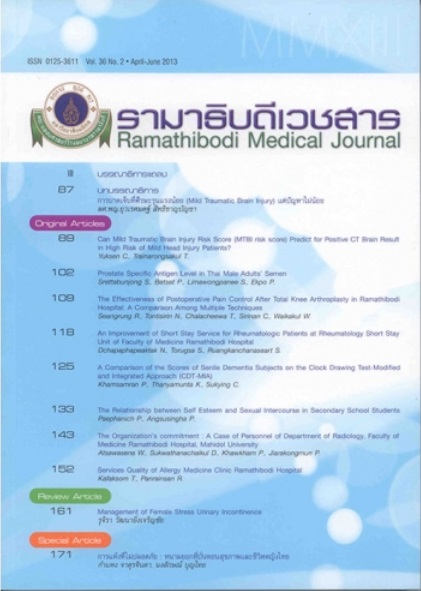The Relationship Between Self Esteem and Sexual Intercourse in Secondary School Students
Keywords:
Self-esteem, Sexual intercourse in secondary school studentsAbstract
Objective: To study the relationship between self esteem and sexual intercourse in secondary school students.
Method: This was a cross-sectional descriptive study. The grade 9 students from Nawaminthrachinutit Satriwittaya Phutthamonthon school were recruited in this study. After being allowed by their parents to participated in the study, all participants completed the questionnaire asking about general information and history of sexual intercourse experiences. The student's self-esteem was assessed with the Thai versions of the Rosenberg self-esteem scale. Pearson's Chi-square, Fisher's exact test and multiple logistic regression were used to analyze the relationship between self esteem and sexual intercourse.
Results: A total of 379 students completed the questionnaire. There were 26 students (6.8%) who has history of sexual intercourse. Factors which correlated significantly with past experience of sexual intercouses, by using Chi-square test, were male gender (P = 0.017), GPA lower than 2 (P = 0.001), living with only mother or father (P = 0.035) and divorced of parents or father/mother have passed away already (P = 0.045). However, after further assessment with multiple logistic regression, there was only one factor that related with history of sexual intercourse in students which was GPA lower than 2.
Conclusion: Self-esteem was not associated with history of sexual intercourse but a lower GPA was associated with history of sexual intercourse among secondary school students.
References
Scholl TO, Hediger ML, Belsky DH. Prenatal care and maternal health during adolescent pregnancy: a review and meta-analysis. J Adolesc Health. 1994;15(6):444-56.
Kovavisarach E, Chairaj S, Tosang K, Asavapiriyanont S, Chotigeat U. Outcome of teenage pregnancy in Rajavithi Hospital. J Med Assoc Thai. 2010;93(1):1-8.
Torrone EA, Wright J, Leone PA, Hightow-Weidman LB. Pregnancy and HIV infection in young women in North Carolina. Public Health Rep. 2010;125(1):96-102.
Gupta N, Kiran U, Bhal K. Teenage pregnancies: obstetric characteristics and outcome. Eur J Obstet Gynecol Reprod Biol. 2008;137(2):165-71.
Briggs MM, Hopman WM, Jamieson MA. Comparing pregnancy in adolescents and adults: obstetric outcomes and prevalence of anemia. J Obstet Gynaecol Can. 2007;29(7):546-555. doi:10.1016/S1701-2163(16)32506-3.
Watcharaseranee N, Pinchantra P, Piyaman S. The incidence and complications of teenage pregnancy at Chonburi Hospital. J Med Assoc Thai. 2006;89 Suppl 4:S118-23.
Avery L, Lazdane G. What do we know about sexual and reproductive health of adolescents in Europe?. Eur J Contracept Reprod Health Care. 2008;13(1):58-70.
Brener N, Kann L, Lowry R, Wechsler H, Romero L.Trends in human immunodeficiency virus-related risk behaviors among high school students-United States, 1991-2005. MMWR Morb Mortal Wkly Rep. 2006;11:851-4.
Currie C, Roberts C, Morgan A, et al. Young people’s health in context: international report from HBSC 2001/2002 survey. Copenhagen: World Health Organization Regional Office for Europe; 2004:153-60.
Teitler JO. Trends in Youth Sexual Initiation and Fertility in Developed Countries: 1960-1995. Ann Am Acad Political Sci. 2002;580:134-52.
Bureau of Reproductive Health, Department of Health, Ministry of Public Health. https://rh.anamai.moph.go.th/all_file/index/teen_edit%208-01-2556.pdf.
Bureau of Health Promotion, Department of Health, Ministry of Public Health. http:saiyaurakhospital.com/newdemo/admin/user_report.html.
Wheeler SB. Effects of self-esteem and academic performance on adolescent decision-making: an examination of early sexual intercourse and illegal substance use. J Adolesc Health. 2010;47(6):582-90. doi:10.1016/j.jadohealth.2010.04.009.
Kalina O, Geckova AM, Klein D, et al. Psychosocial factors associated with sexual behaviour in early adolescence. Eur J Contracept Reprod Health Care. 2011;16(4):298-306. doi:10.3109/13625187.2011.586076.
Doswell WM, Braxter BJ, Cha E, Kim KH. Testing the theory of reasoned action in explaining sexual behavior among African American young teen girls. J Pediatr Nurs. 2011;26(6):e45-54. doi:10.1016/j.pedn.2011.03.007.
Santelli JS, Kaiser J, Hirsch L, Radosh A, Simkin L, Middlestadt S. Initiation of sexual intercourse among middle school adolescents: the influence of psychosocial factors. J Adolesc Health. 2004;34(3):200-8.
Goodson P, Buhi ER, Dunsmore SC. Self-esteem and adolescent sexual behaviors, attitudes, and intentions: a systematic review. J Adolesc Health. 2006;38(3):310-9.
Thangjitpukdeesakul T. Factors related to self-esteem and hopelessness among juvenile delinquents in the central observation and protection center. Journal of Clinical Psychology. 2002; 33(1):43-54.













